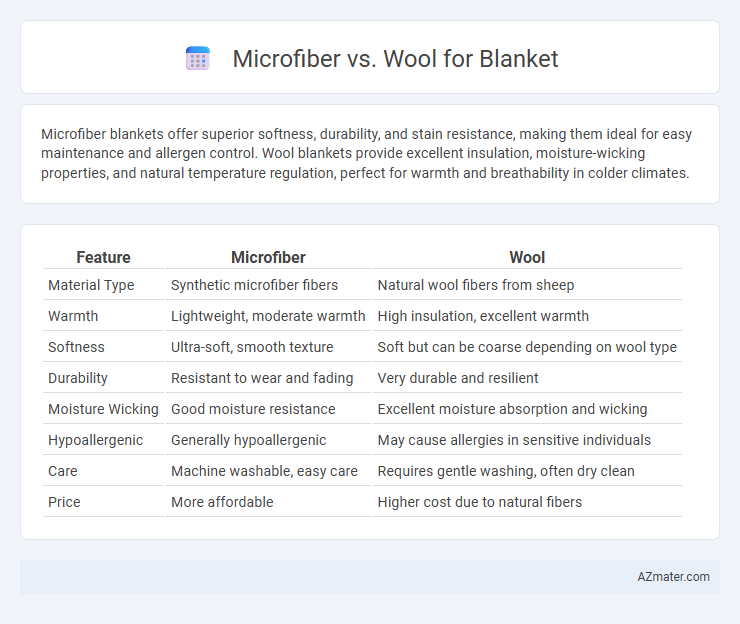Microfiber blankets offer superior softness, durability, and stain resistance, making them ideal for easy maintenance and allergen control. Wool blankets provide excellent insulation, moisture-wicking properties, and natural temperature regulation, perfect for warmth and breathability in colder climates.
Table of Comparison
| Feature | Microfiber | Wool |
|---|---|---|
| Material Type | Synthetic microfiber fibers | Natural wool fibers from sheep |
| Warmth | Lightweight, moderate warmth | High insulation, excellent warmth |
| Softness | Ultra-soft, smooth texture | Soft but can be coarse depending on wool type |
| Durability | Resistant to wear and fading | Very durable and resilient |
| Moisture Wicking | Good moisture resistance | Excellent moisture absorption and wicking |
| Hypoallergenic | Generally hypoallergenic | May cause allergies in sensitive individuals |
| Care | Machine washable, easy care | Requires gentle washing, often dry clean |
| Price | More affordable | Higher cost due to natural fibers |
Introduction to Microfiber and Wool Blankets
Microfiber blankets are crafted from ultra-fine synthetic fibers, offering exceptional softness, durability, and resistance to wrinkles and stains. Wool blankets, made from natural animal fibers, provide superior insulation, moisture-wicking capabilities, and breathability, making them ideal for temperature regulation. Both materials deliver distinct benefits, with microfiber excelling in ease of care and affordability, while wool delivers natural warmth and long-lasting comfort.
Material Composition: Microfiber vs Wool
Microfiber blankets are made from finely woven synthetic fibers such as polyester, offering lightweight, durable, and moisture-wicking properties. Wool blankets consist of natural animal fibers, primarily from sheep, known for excellent insulation, breathability, and moisture absorption. The choice between microfiber and wool depends on preferences for synthetic durability versus natural warmth and eco-friendliness.
Softness and Comfort Comparison
Microfiber blankets offer exceptional softness due to their ultra-fine synthetic fibers that mimic the smoothness of silk, providing a lightweight and cozy feel against the skin. Wool blankets, particularly those made from merino or cashmere, deliver natural warmth and breathability with a slightly textured softness that enhances comfort during colder months. While microfiber excels in being hypoallergenic and moisture-wicking, wool provides superior insulation and durability, making the choice dependent on specific comfort needs and climate conditions.
Warmth and Insulation Properties
Microfiber blankets offer excellent warmth due to their dense synthetic fibers that effectively trap heat and provide lightweight insulation. Wool blankets naturally excel in insulation by using crimped fibers that create air pockets, maintaining warmth even when damp and allowing breathability. Both materials provide superior heat retention, but wool's moisture-wicking capability enhances comfort in varying temperatures.
Breathability and Moisture Control
Microfiber blankets offer superior moisture-wicking properties, keeping users dry by rapidly evaporating sweat, making them ideal for warmer climates or active sleepers. Wool blankets excel in breathability and natural temperature regulation, allowing moisture to escape while retaining warmth, which benefits cold-weather use and prevents overheating. Both materials provide effective moisture control, but wool's natural fibers outperform microfiber in balancing breathability with insulation.
Hypoallergenic Qualities
Microfiber blankets are highly hypoallergenic due to their synthetic fibers that resist dust mites, mold, and allergens, making them ideal for sensitive skin or allergy sufferers. Wool blankets, while naturally resistant to dust mites and moisture-wicking, can sometimes cause irritation for individuals with wool sensitivities or allergies. Choosing microfiber blankets often provides a safer, more hypoallergenic option compared to wool, especially for those prone to allergic reactions.
Durability and Longevity
Microfiber blankets are known for their exceptional durability due to tightly woven synthetic fibers that resist pilling and wear, making them ideal for frequent use and easy maintenance. Wool blankets offer natural resilience and longevity, thanks to their robust fiber structure that repels moisture and retains warmth even after years of use. While microfiber excels in stain resistance and quick drying, wool provides superior breathability and maintains its insulating properties over decades.
Care and Maintenance Differences
Microfiber blankets require minimal maintenance, as they are machine washable, quick-drying, and resistant to wrinkles, making them ideal for everyday use. Wool blankets need more careful handling, often requiring hand washing or dry cleaning to preserve their natural fibers and prevent shrinking or felting. Proper care of wool blankets includes air drying flat to maintain shape, while microfiber blankets can be tumble dried on low heat without damage.
Eco-Friendliness and Sustainability
Microfiber blankets, made from synthetic fibers like polyester, often rely on non-renewable petroleum resources and contribute to microplastic pollution, raising concerns about their long-term environmental impact. Wool blankets are natural, biodegradable, and renewable, sourced from sheep with responsible farming practices enhancing soil health and reducing carbon footprints. Sustainable wool production supports eco-friendly blankets by minimizing chemical use and promoting animal welfare, making wool a more environmentally conscious choice compared to microfiber.
Choosing the Best Blanket for Your Needs
Microfiber blankets offer superior softness, stain resistance, and affordability, making them ideal for allergy sufferers and easy maintenance. Wool blankets provide exceptional warmth, natural moisture-wicking properties, and durability, catering to those needing heavy insulation and breathability. Selecting the best blanket depends on prioritizing comfort, warmth level, and care requirements specific to your lifestyle.

Infographic: Microfiber vs Wool for Blanket
 azmater.com
azmater.com